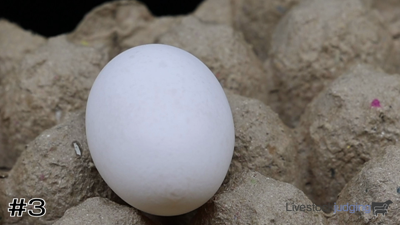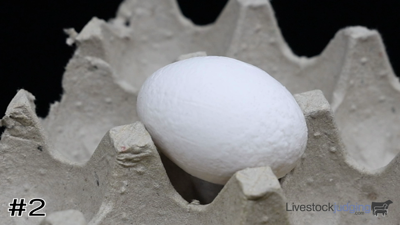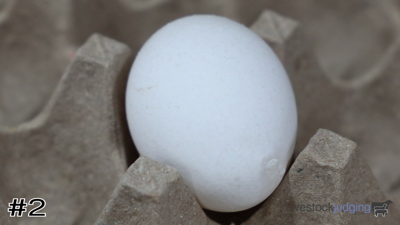Exterior Egg Grading
Checked [NG]
This egg shell's got a tiny, hair-like crack in it, almost like a delicate line drawn on the surface. It's just a small flaw on the surface that doesn't affect the inside of the egg.
Dented Checked [NG]
This egg shell has a bit more than a hairline crack; it's actually dented in a bit. But even though it looks a bit rough, the inside membranes are still doing their job, and nothing's leaking out.
Leaker [NG]
This egg shell has a crack that's gone beyond just a surface issue. The membranes are broken, and that lets the inside of the egg start to leak out.
Slight / Moderate Stain [B]
This egg shell has some small stains on it. If the stains are just in one area and cover less than 1/32 of the shell, that's considered slight. If the stains are scattered around but still cover less than 1/16 of the shell, that's considered moderate.
Prominent Stain [NG]
This egg shell has some noticeable stains. If the stains are in one area and cover more than 1/32 of the shell, or if they're scattered around and cover more than 1/16 of the shell, that's considered a prominent stain. This is a bit more than just slight or moderate staining.
Adhering Dirt / Foreign Material [NG]
This egg shell has something you don't want on it, like dirt or other unwanted stuff (including blood, yolk, egg white, or fecal material) that's sticking to the shell. It's not just a stain; it's material that's actually adhered to the surface.
Decidedly Misshapen [B]
This egg shell has a shape that's really out of the ordinary. Maybe it's rounder, longer, more pointed, or just distorted in some way, affecting a large part of the shell's surface. But be careful not to mix this up with other abnormalities like ridges, calcium deposits, or rough surfaces, and bulges from body checks, thin spots, or cracked shells. Those aren't considered decidedly misshapen; this term is for more pronounced shape issues.
Large Calcium Deposits [B]
This egg shell has some rough areas due to calcium deposits. A few small ones won't really hurt the egg's strength, but if there are rough patches of calcium deposits, they can make the shell less sound or strong.
Body Check [B]
If the shell cracks inside the hen's body, the hen might repair it by adding more calcium over the crack, resulting in a ridged area. It's like a natural patch job. But don't confuse a "body check" with other issues like pronounced thin spots or being decidedly misshapen. Those terms don't apply when the issue is caused by a body check. It's its own unique thing.
Pronounced Ridges [B]
This egg shell has some definite ridges that mess with its shape. Unlike slight bumps or textures, these ridges are more noticeable and can make the egg look and feel a bit different.
Pronounced Thin Spots [B]
This egg shell has certain areas that are noticeably thinner. Unlike just a minor inconsistency in the shell, these thin spots are quite obvious and might make you feel a bit wary about how strong the shell is in those areas.
No Defect [AA/A]
It's got a clean shell, no stains or stuff stuck to it, and its shape is just right: oval with one end larger than the other, tapering down to the smaller end. The shell is solid and robust, without much in the way of calcium deposits, no body checks, and only slight ridging if any at all..

2023 PSS #6
This class has been viewed 6 times over the past month

2025 PSS #6
This class has been viewed 12 times over the past month

2024 PSS #6
With explanation by TAMU officials

2024 PSS #6
This class has been viewed 10 times over the past month

2023 SALE #6
Exterior eggs with critique by TAMU officials

2024 PSS #6
This class has been viewed 5 times over the past month

2025 SALE #6
This class has been viewed 176 times over the past month

2025 PSS #6
This class has been viewed 93 times over the past month